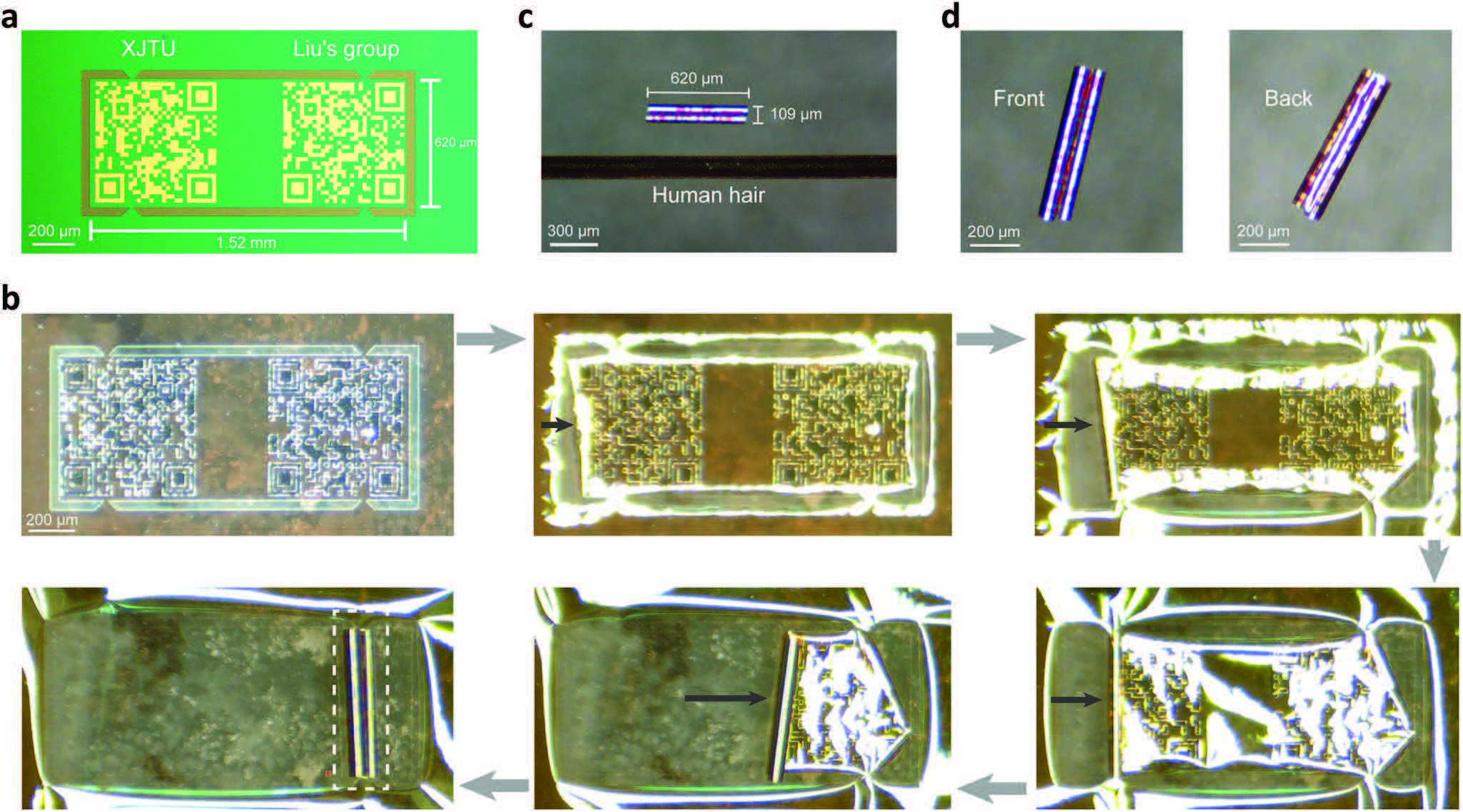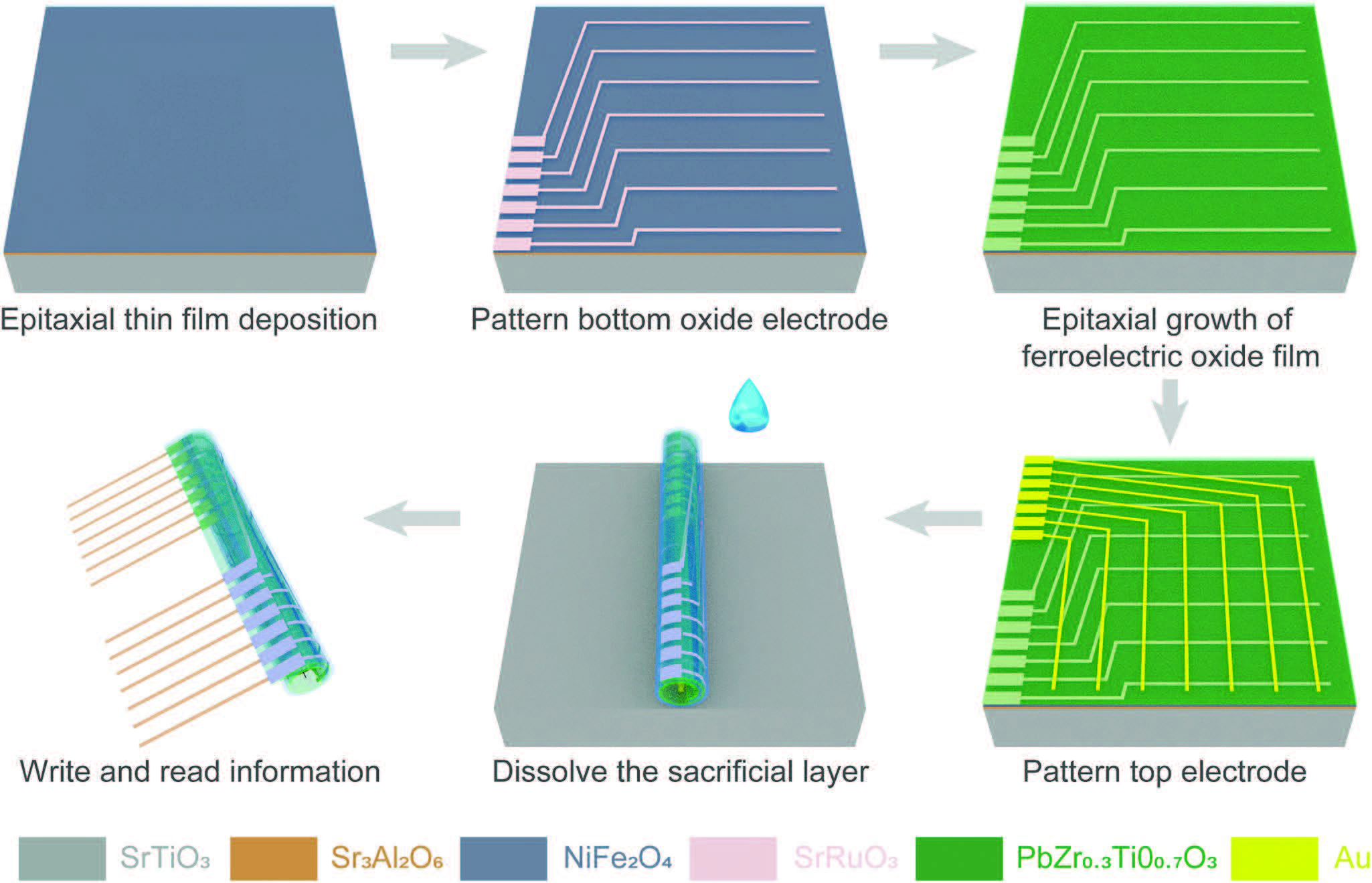| May 15, 2023 | |
Achieving ultrahigh-density information storage with self-rolling ferroic oxide films |
|
| (Nanowerk Spotlight) Ferroelectric memory, a type of nonvolatile memory, offers significant advantages in terms of speed, power efficiency, and durability, making it a promising candidate for next-generation memory technology. To meet the growing demand for higher data storage density in ferroelectric memories, researchers have developed a novel approach inspired by scroll-like storage methods. | |
| Traditional methods of increasing storage density involve reducing the size of memory cells or creating 3D stacks of cells. However, reducing memory cell size faces physical limitations, and integrating single-crystalline ferroelectric oxide films in 3D stacks remains challenging. To overcome these limitations, researchers have introduced a method that allows single-crystalline ferroelectric oxides to self-roll-up into scroll-like 3D memory structures. | |
| They report their findings in a recent paper in Advanced Functional Materials ("Self-Rolling-Up Enabled Ultrahigh-Density Information Storage in Freestanding Single-Crystalline Ferroic Oxide Films"). | |
 |
|
| Self-rolling-up enabled high-density information storage in ferroic oxide membranes. a) Optical image of the flat and pre-patterned thin films with QR codes. b) Optical image of the self-rolling-up process (the black arrow indicates the rolling-up direction). c) Optical image of the scroll in comparison with human hair. d) The front (left) and back (right) sides of the scroll. (Reprinted with permission by Wiley-VCH Verlag) | |
| In the study, the researchers chose a prototype film made of PbZr0.3Ti0.7O3 (PZT), a type of ferroelectric oxide. This material was grown on a stressor layer made of another oxide, which had a slight lattice mismatch, meaning the atoms in the crystal structures of the two materials did not line up perfectly. The PZT/stressor structure was then detached from the substrate on which it was grown. | |
| This release process is where the magic happened: the internal stress caused by the lattice mismatch between the two materials made the PZT/stressor film roll up on its own, like a scroll. This phenomenon, called "self-rolling-up," transformed the flat membrane into a 3D structure. | |
| Next, the researchers applied piezoelectric force microscopy, a method that uses the mechanical stress to switch the polarization in the ferroelectric material. They used this method to write high-density information onto the flat PZT/stressor membranes before the self-rolling-up occurred. In the rolled-up state, the membranes showed an impressive enhancement in information density — up to 45 times greater than before. | |
| This self-rolling-up behavior is not just an experimental curiosity; it has significant theoretical underpinnings as well. The freestanding PZT/stressor membranes have a strong intrinsic tendency to roll up, driven by the mismatch in their atomic structures. This tendency can result in an area ratio enhancement of 100-450 times, which translates into an ultrahigh-density information storage capacity of 100 Tbit/In2. | |
 |
|
| Schematics of self-rolling-up of freestanding membrane with a cross-bar structure. It includes epitaxial thin film deposition, pattern bottom single-crystalline oxide electrode, epitaxial growth of ferroelectric oxide film, pattern top metallic electrode, dissolve the sacrificial layer to obtain scrolls, and write and read information. (Reprinted with permission by Wiley-VCH Verlag) | |
| In conclusion, the researchers developed a new method for information storage that capitalizes on the self-rolling-up properties of ferroic oxide films. This method involves writing information onto a nanofilm and then allowing the film to roll up and store the data in a 3D scroll form. | |
| This approach has been demonstrated to increase storage density by approximately 45.7 times, compared to traditional planar structures. Theoretically, the self-rolling-up method can achieve an ultrahigh-density information storage of 100 Tbit/In2. | |
| In addition to its impressive storage density, this method also has several other advantages. It employs a simple preparation process, allows for strong heterogeneous integration, and is compatible with mass production techniques. | |
| The authors conclude that "this method can be applied to any bilayer ferroic oxide film structure with internal stress, which provides a new path for the development of high-density information storage." | |
 By
Michael
Berger
– Michael is author of three books by the Royal Society of Chemistry:
Nano-Society: Pushing the Boundaries of Technology,
Nanotechnology: The Future is Tiny, and
Nanoengineering: The Skills and Tools Making Technology Invisible
Copyright ©
Nanowerk LLC
By
Michael
Berger
– Michael is author of three books by the Royal Society of Chemistry:
Nano-Society: Pushing the Boundaries of Technology,
Nanotechnology: The Future is Tiny, and
Nanoengineering: The Skills and Tools Making Technology Invisible
Copyright ©
Nanowerk LLC
|
|
|
Become a Spotlight guest author! Join our large and growing group of guest contributors. Have you just published a scientific paper or have other exciting developments to share with the nanotechnology community? Here is how to publish on nanowerk.com. |
|
